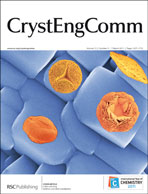Three upper rim site lipophilic calix[4]arenes 1–3 featuring different para-alkanoyl substituents at the phenolic moieties, i.e.n-hexanoyl, n-octanoyl and 3-cyclohexylpropanoyl groups, are reported to complex, aside from the common solvent molecule n-butanol, different keto and hydroxylic terpene guest molecules such as (−)-menthone, (−)-menthol or (+)-carvone in the solid state. Although for all six inclusion compounds described here, a strict 1 : 1 host : guest stoichiometry is observed, complementary size and polarity relationships between the cone shaped calixarene cavity and the guest molecule emerge from single crystal X-ray structural study. Dependent on the structure of the guest molecule, the calixarenes are arranged in a head-to-head or head-to-tail orientation in the crystalline packing, giving rise to capsular or otherwise deeply enclosed inclusion mode of the guest molecules, respectively. Furthermore, the O-acyl atoms of the calixarenes were found to be directly involved in host–guest interaction. In order to estimate the degree of isostructurality of the host frameworks and to examine the influence of the guest molecules on the solid-state conformation of these calixarene molecules, isostructurality comparison, cell similarity and molecular isometricity calculations were carried out revealing a rare case of supramolecular morphotropism for the pair of (−)-menthone and (−)-menthol inclusions of the n-hexanoyl substituted calixarene. Structure–inclusion property relationship was examined by QMB measurements of thin layers of the calixarenes. Vapor studies with different terpenes and common organic solvents show an increased affinity towards guest molecules with polar functionalities, whereas small solvent molecules like acetone are bound considerably better than the more bulky terpene molecules.
![Graphical abstract: Upper rim site lipophilic calix[4]arenes as receptors for natural terpenes and functionally related solvent molecules: combined crystal structure and QMB sensor study](/en/Image/Get?imageInfo.ImageType=GA&imageInfo.ImageIdentifier.ManuscriptID=C0CE00696C&imageInfo.ImageIdentifier.Year=2011)
You have access to this article
 Please wait while we load your content...
Something went wrong. Try again?
Please wait while we load your content...
Something went wrong. Try again?
![Graphical abstract: Upper rim site lipophilic calix[4]arenes as receptors for natural terpenes and functionally related solvent molecules: combined crystal structure and QMB sensor study](/en/Image/Get?imageInfo.ImageType=GA&imageInfo.ImageIdentifier.ManuscriptID=C0CE00696C&imageInfo.ImageIdentifier.Year=2011)

 Please wait while we load your content...
Please wait while we load your content...